FROM OUR COLLECTIONS

The Skull of Abbot Ralph?
This skull and its skeleton were found during excavations of the Cistercian monastery at Abbey Farm. Unusually, the brick-lined grave was found in the cloister at the Chapter House door, a location which might suggest a former abbot. The skull showed signs of a head wound and there were cockleshells at the feet, symbolic of pilgrimage. Could this be the burial place of Ralph, the sixth Abbot of Coggeshall Abbey from 1207 to 1218? He was a participant in the Third Crusade, during which we know he suffered a head injury which was to cause him considerable pain for the rest of his life and which may have been the cause of his retirement as abbot in 1218.
Chosen by Museum volunteer Dudley Maughan
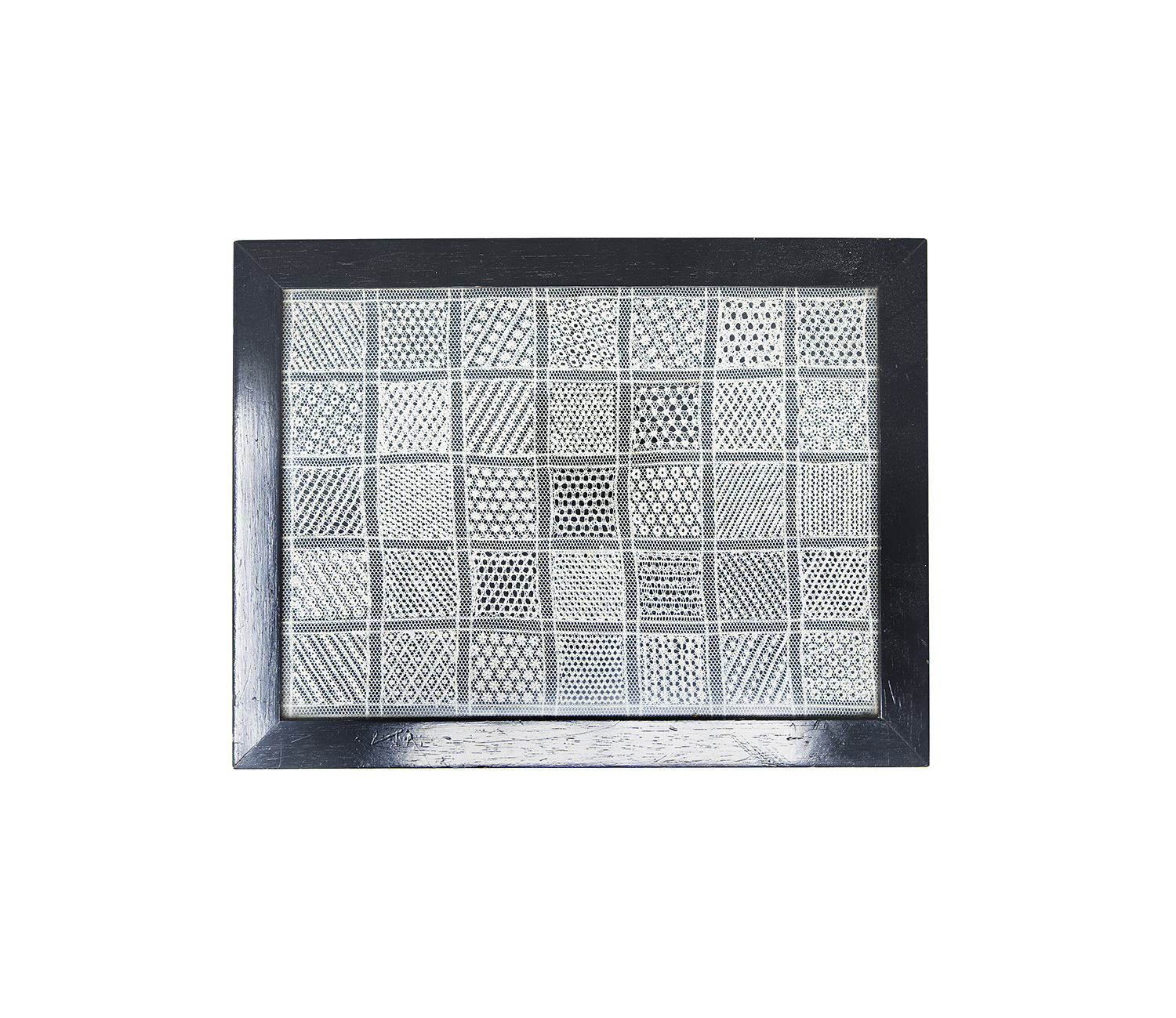
Coggeshall Tambour Lace Sampler of Stitches
This sampler dating from 1912 shows the variety of patterns used in Coggeshall lace and was produced by Rosa Thorpe.
Each of the squares is about 25mm wide.
Chosen by museum volunteer Cedric Mullis.
‘I chose this little sampler not just for its own sake but also because it reminds me of Pam Maclean who was a very skilled needlewoman and was called in to help restore precious vestments at Westminster Abbey.’

Html Light Grey background ignore this text it is just to increase the picture size
ignore this text it is just to increase the picture size
ignore this text it is just to increase the picture size
ignore this text it is just to increase the picture size
Scales for Weighing Coggeshall’s Babies
These scales were used to weigh all the babies born in Coggeshall before and after my birth in 1948. It is the one item in the museum that links my generation and I can still imagine it on the end of the counter in “Pinkies”, the Chemist. When I look at the panoramic school photos on the notice boards, I chuckle that pretty much everybody who is pictured has had their bum in those scales at some point and how many of those are no longer with us.
The scales are L 70cms, H 31cms and W 33cms including the basket
Chosen and described by museum volunteer Doug Judd
Html Light Grey background ignore this text it is just to increase the picture size
ignore this text it is just to increase the picture size
ignore this text it is just to increase the picture size
ignore this text it is just to increase the picture size

Punishment Book and Cane
The punishment book is from the ‘British School’ on Queen Street which was run by the Congregational Church. (There is more information about the church and the school under the ‘Historic Buildings’ section of this website.) The vicious looking cane may also have come from there but we don’t know for sure.
Such punishments were a normal feature of school life until comparatively recently. A rather poignant entry in the book for Olive Sparrow and Phyllis Rayner – ‘1 gentle stroke on the hand’ for playing in class – as if the teacher was reluctant to administer the punishment but felt compelled for some reason to do so. And there is poor Harold Hull for ‘continued inattention, 1 stroke on the hand and 2 behind’. His brother Cyril also features. Most of the names only appear once – on this page at least.
The cane is about 68 cms in length.

Basket made using Plaited Straw
Straw plaiting was a cottage industry that saw its heyday in eighteenth and nineteenth century rural Britain and was carried out by women and children. Started locally at Gosfield to alleviate the distress arising from the collapse of the cloth trade, straw-plaiting spread to most villages in north Essex where there had been wool spinners. Before being plaited the stems of straw had to be split and flattened, a process which was dramatically simplified when two French prisoners made the first straw-splitter sometime between 1803 and 1806 at the height of the Napoleonic wars. One of these splitters can be seen on display in the museum near the basket illustrated. Much of the finished plait was bought by milliners from Luton and made into hats but at one time there were five straw hat makers in Coggeshall itself and several score of straw plaiters at work but by 1870 straw plaiting as an occupation had ceased in the town. The basket illustrated is an unusual example of the craft and includes the use of cane to form the basic structure.
Chosen by museum volunteer Trevor Disley
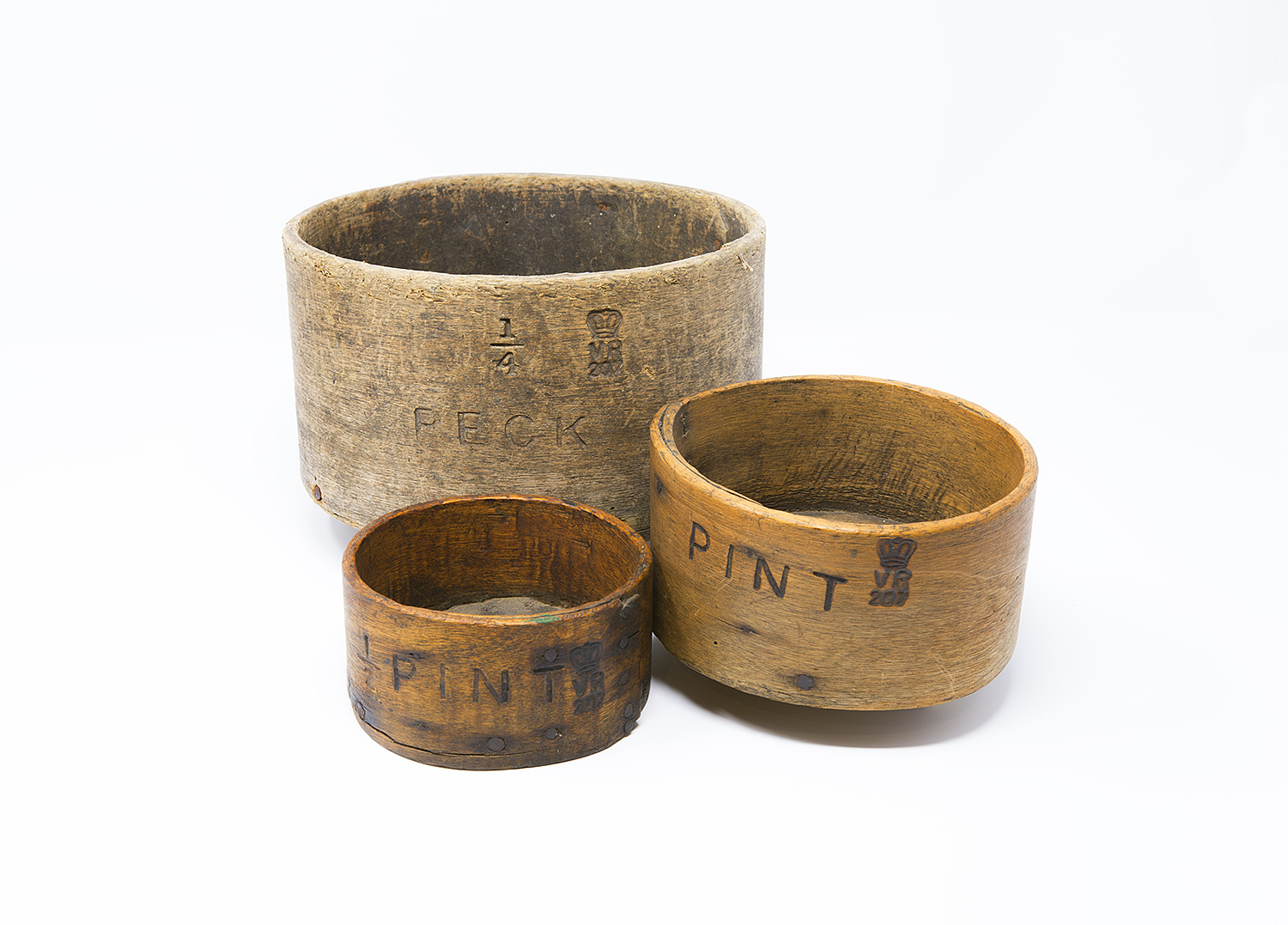
Victorian Seed Measures from J K King & Son
Seed is measured in volume not weight and these are in the old imperial units. The container would be over-filled with seed and then a straight edge (called a strike) drawn across the top to throw off the excess seed leaving the container evenly filled to the brim. The volume of each measure was a legal quantity and was certified by an official stamp showing VR (Victoria Regina) with a crown above.
The measures shown are half-pint, pint and one quarter of a peck. A peck is sixteen pints so a quarter of a peck is four pints. A larger measure, a bushel (not shown here), is equal to four pecks or 64 pints.
For those familiar with metric measures a peck is just over 9 litres

Water Pipe from Coggeshall Abbey
This tapered, socket and spigot pipe, is some 700 – 800 years old. It carried fresh water perhaps from a spring now lost, called ‘Stokewell’ into the Abbey precinct. Several such pipes were discovered in 1887 during drainage work in Claypit Field just east of the monastery.
The pipe was made at the medieval kilns at Tilkey which were also responsible for the earliest bricks produced in England since Roman times. If you look closely you can see the cut marks where the spigot was cut or trimmed with a knife before firing and looking as fresh now as they did all those years ago when they were made.
Each section of pipe is about 38cms long and tapers from about 10cms to 8cms with a bore of 4cms.

Floor Tile from Coggeshall Abbey
This floor tile was discovered during excavations of Coggeshall Abbey carried out by Mr John Gardner MA in the 1950s. It came from the abbey cloister close to a brick-lined grave, perhaps that of Abbot Ralph. Other floor tiles found in the cloister were plain so these decorated examples must have marked a special place. If this was the resting place of Abbot Ralph perhaps the symbols are related to the Crusades. Alternatively they could be the formalised representations of the cross with the sun and the moon which were often associated with the Crucifixion in fourteenth century illustrations. The tile is approximately 12 cms square.

A compilation showing how the tiles might have appeared on the cloister floor. After 300 years or so of wear and another 300 years buried, they understandably look a little worn!
To make the tiles, the local terracotta clay was decorated with a slip (liquid clay) in two colours; first yellow ochre was applied cross the whole surface and then the design applied in dark brown/black. Here and there a little of the original bright ochre colour can be seen.
Html Light Grey background ignore this text it is just to increase the picture size
ignore this text it is just to increase the picture size
ignore this text it is just to increase the picture size
ignore this text it is just to increase the picture size
ignore this text it is just to increase the picture size
ignore this text it is just to increase the picture size
ignore this text it is just to increase the picture size
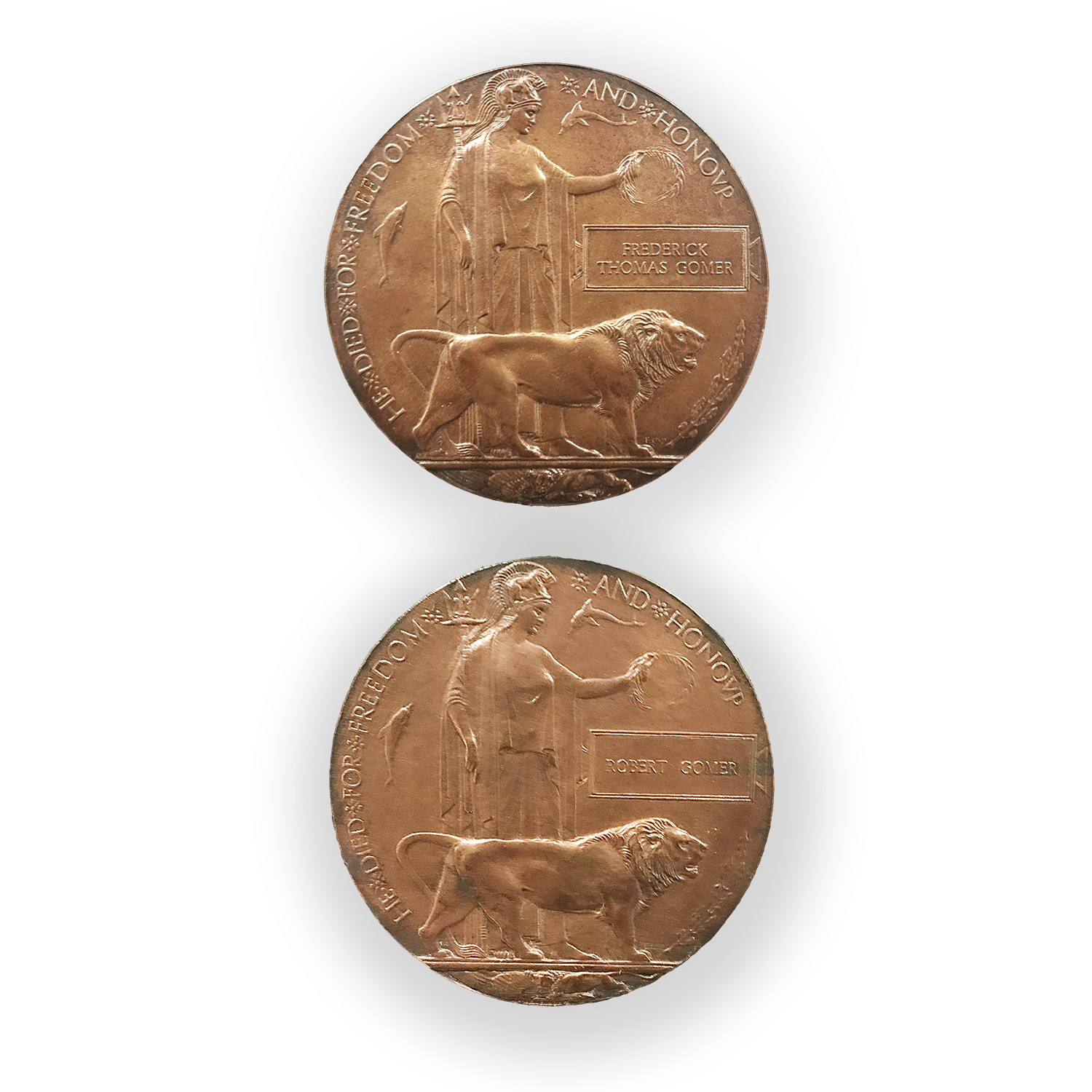
Bronze Memorial Plaques
These plaques were issued after the First World War to the next-of-kin of all British and Empire service personnel who were killed as a result of war. They became known as the ‘Dead Man’s Penny’ as a least superficially they looked like a larger version of that coin. The design was the result of a competition and the winner, sculptor and medallist Edward Carter, received a prize of £250. Some 1,355,000 plaques were issued using 450 tons of bronze. They are 12 cms in diameter.
Frank and Eliza Gomer lived on Grange Hill and Frank was a roadman for the Essex County Council. They had three sons and two of them were to die in the Great War. Robert Gomer was the eldest and had been a farm labourer until he joined the army. He died on 6th August 1915 aged 21. Frederick Thomas Gomer was their second son. He had worked in a butchers shop before he enlisted in Braintree and went to France in April 1915. He died on 4th October 1918 aged 19.
The family very generously donated these plaques to the museum.
Chosen by the late Shirley Ratcliffe who played a key role in the development of our museum. Shirley, with her husband Malcolm, had a long connection with the British Legion and carried out all the research for the Coggeshall Book of Remembrance, the ‘Roll of Honour’. This can be seen elsewhere on this website and in the museum itself.
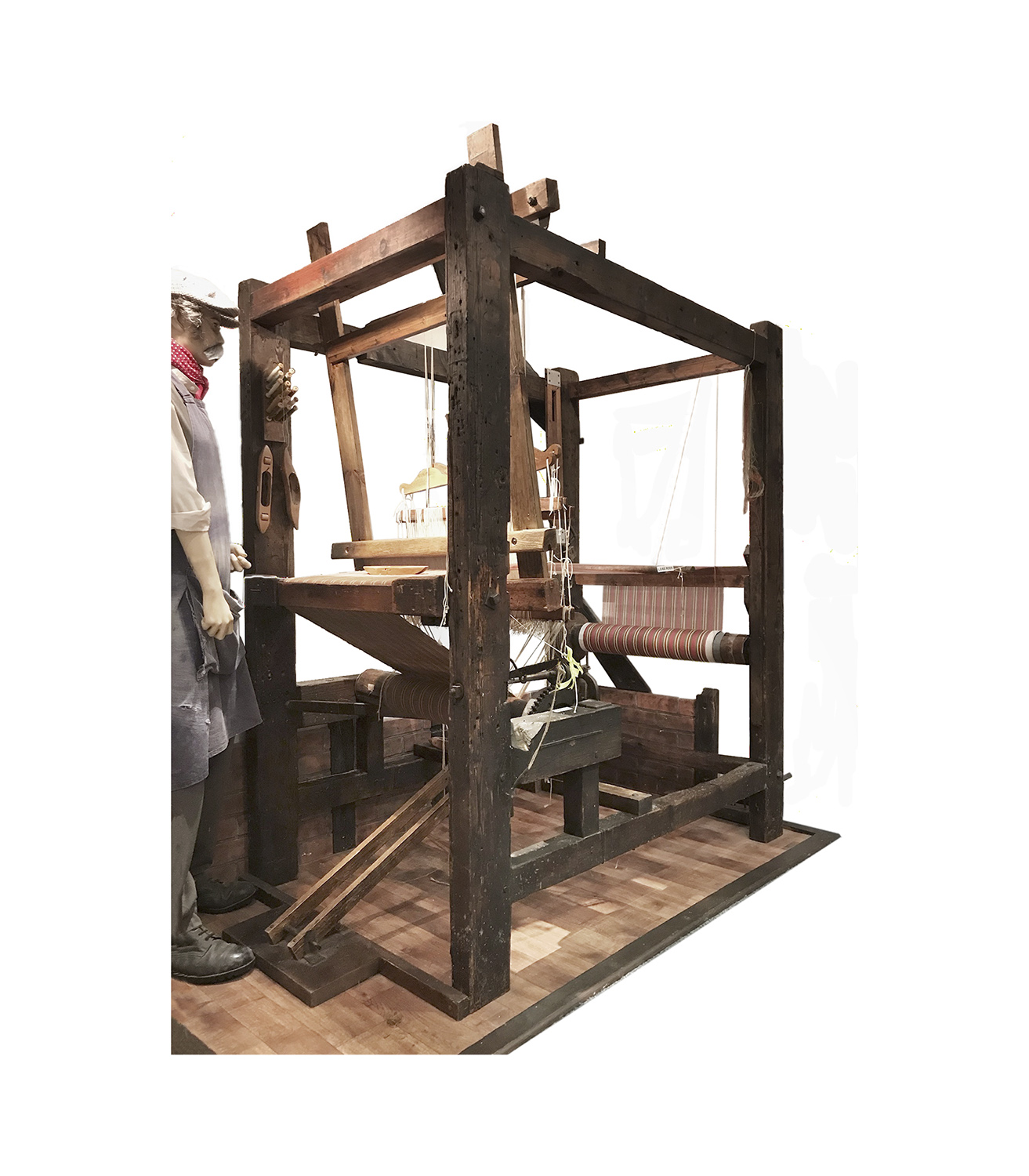

Neolithic Axe head found at Tilkey.
About 18cms long, this axe dates from 12,000 – 1,700 years BCE the period when people first began to farm.
Such polished axes were fitted with a wooden handle and were used for the clearing of trees and in the construction of dwellings. After the axe fell out of use it seems to have been used as a hammer as what was once a very sharp edge has been much chipped and damaged.
It was in the collection of John Gardner MA a Coggeshall Historian.

The Coggeshall Minerva
This bronze Roman head, about 4cms in length, was found near Coggeshall in 1996. The British Museum have dated it to the period of the Roman occupation and identified it as part of the mount of a funerary urn (which contained a person’s ashes following cremation). It almost certainly depicts the Goddess Minerva. Roman cemeteries were often adjacent to a main road and on the edge of a settlement and it is thought that one existed in Crow Barn Field north of West Street just outside Coggeshall.
Chosen by museum volunteer Malcolm Ratcliffe
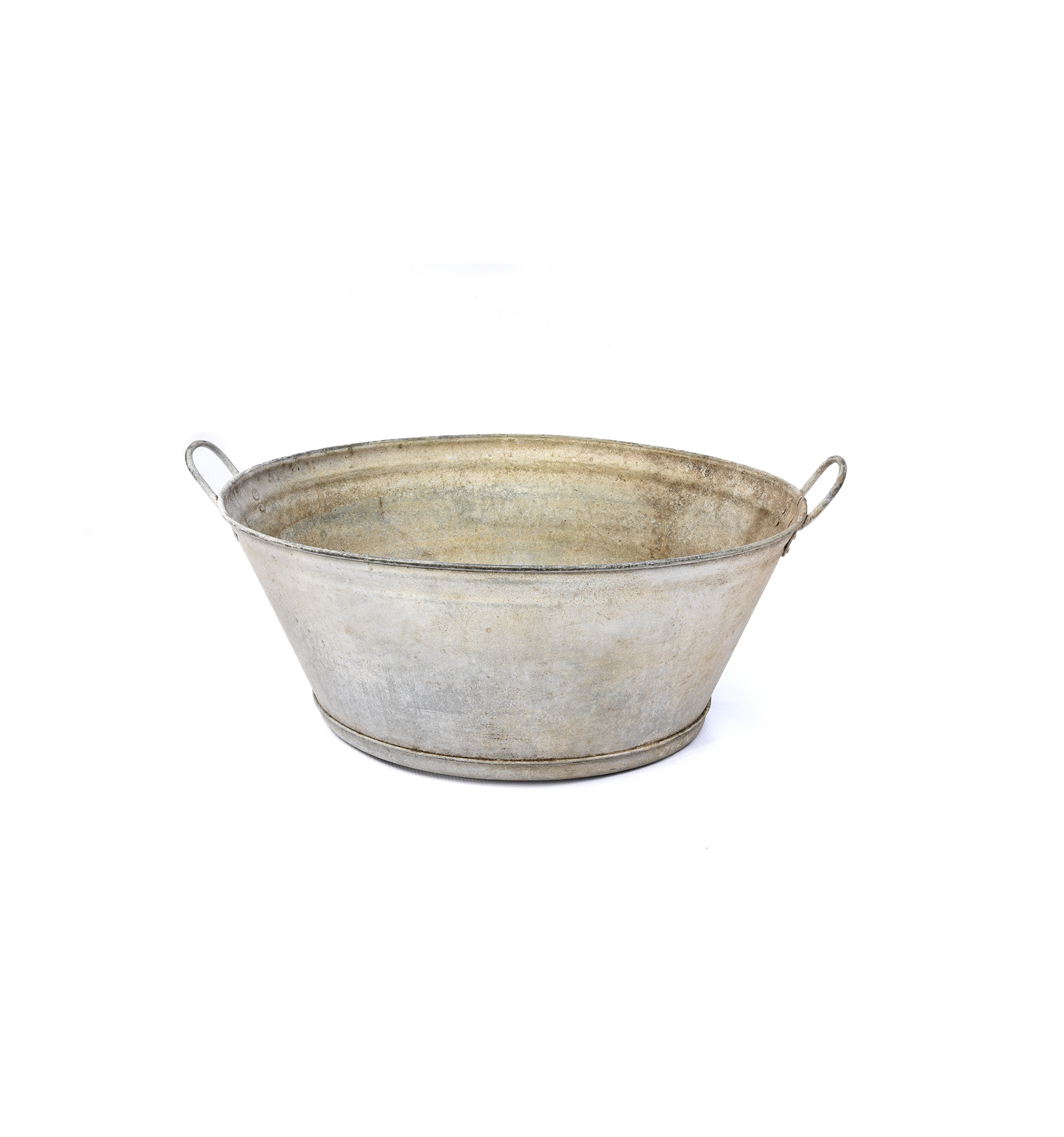
Galvanised ‘Tin Bath’
Once a week in front of the fire in the winter, usually Sunday evening, and outside in the back yard on warmer days. Mum filling up the bath with water boiled in saucepans and a kettle. That was until I outgrew it and was promoted to a bigger tin bath but then I was relegated to third in the queue after mum and dad had had their turn. When I tell this to the youngsters who come to visit the museum nowadays, they can barely believe it. Mostly they’ll say: “Didn’t you have a shower?”
The bath is 70cms by 48cm and 27cms deep
Chosen and described by museum volunteer Doug Judd –
shown here in his bath in about 1950
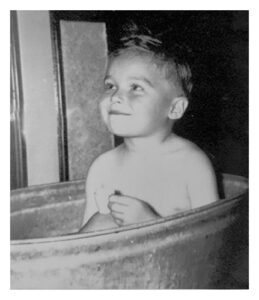

Carved Floral Connected Rings
This carving is the work of Andrew Beckwith whose grandfather, Ernest and father Edward were noted woodcarvers of the Coggeshall School.
Andrew left school at 15 and wanted to try his hand in the family business but his father was not interested in teaching and did not encourage him. So on a snowy January day in 1963 Andrew tramped the streets of Ipswich seeking work as a cabinet maker and was taken on by an old county firm of antique dealers, Green and Hatfield. Here he gained experience of antique furniture restoration. Later Andrew became a partner in a small antique shop, restoring furniture in a backroom workshop while his partner did the buying. These years were successful and enjoyable but a personal crisis led Andrew to spend time in a religious community. Furniture making was never far away as the community chapel was being re-ordered and he was asked to make much of the new furniture. In 1992 Andrew returned to Coggeshall and in 2007 he was commissioned to make the new organ case for St Peter’s church, just over a century after his grandfather had done the same.
Chosen by Shirley Ratcliffe
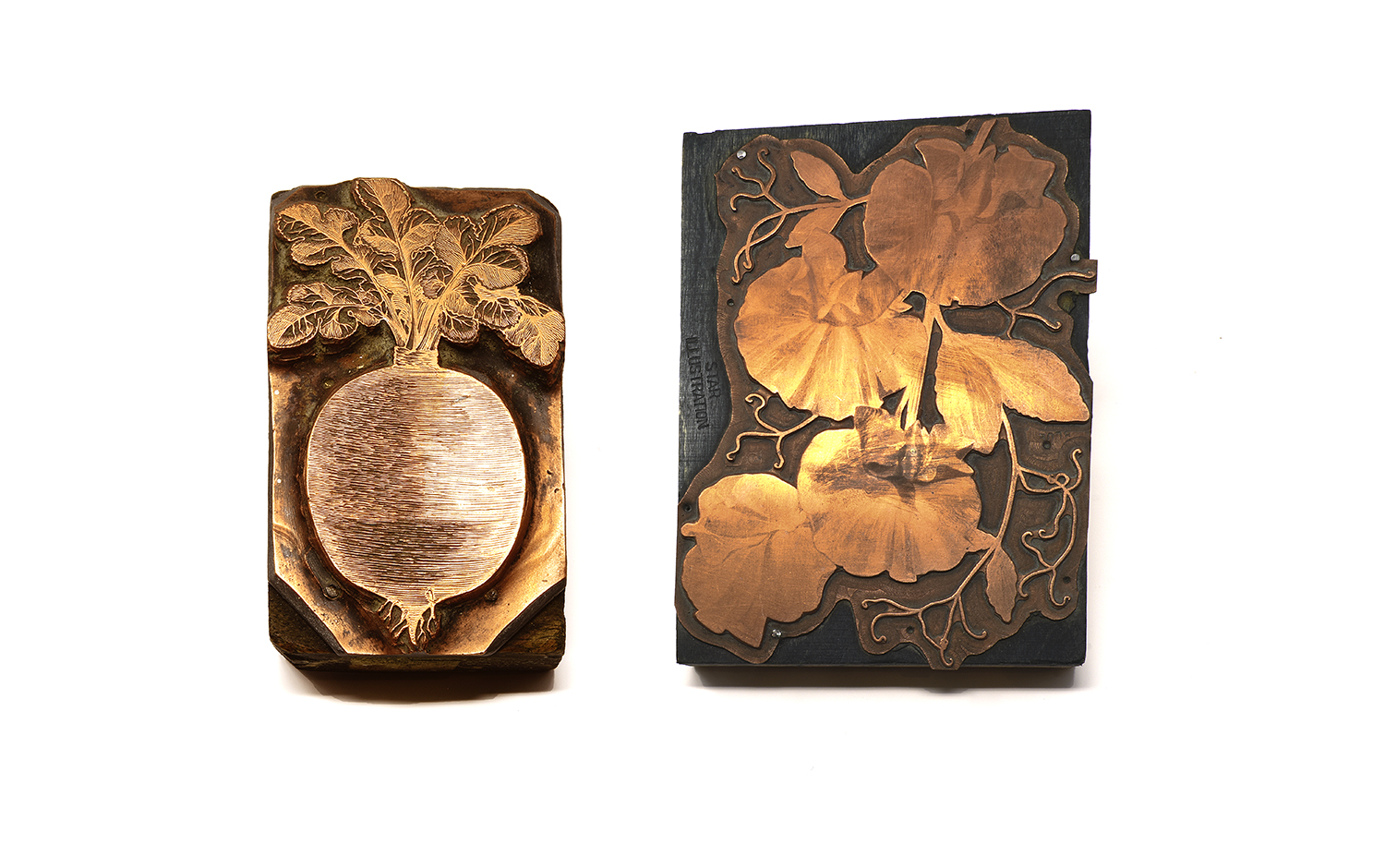
Printing Blocks from J K King & Son
Two copper printing blocks used to illustrate the John K King seed catalogues and seed packets. The one on the left is a traditional hand engraved Victorian plate and may show King’s ‘Imperial Green Globe Turnip’. The right hand plate is of more recent origin – late nineteenth or early 20th century – it’s a half-tone plate mechanically produced from a photograph, perhaps showing a Sweet Pea and with a much finer texture. At the time these were created – along with hundreds of other plates – John K King was one of the leading seed firms in the country and had been granted the Royal Warrant as seedsmen to the Queen and to HRH The Prince of Wales in 1885.
Chosen by museum volunteer Sylvie Overnell
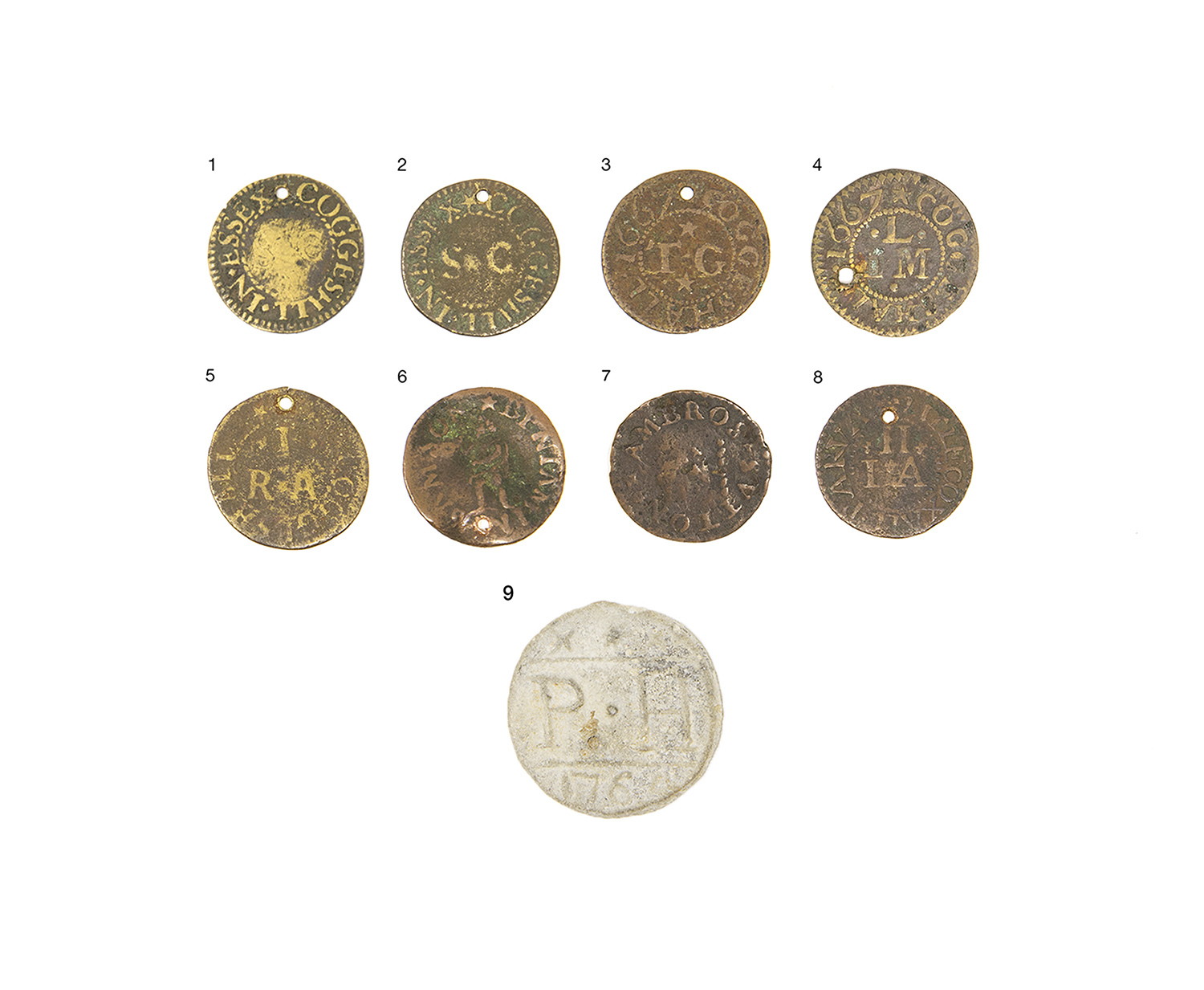
17th Century Coggeshall Trade Tokens
These were issued by Tradesmen instead of ‘real’ money when there was a shortage of coins of small value – specifically farthings – a quarter of a penny. They have been described as ‘an illegal money of necessity’ – a true example of democracy as they were minted by and for ordinary people in response a public need and Government indifference. The coins are about 10mm in diameter except for No.9 which is about 15mm in diameter.
1. Samuel Cox – COGGESHALL IN ESSEX – S.C.
2. Samuel Cox – COGGESHALL IN ESSEX – S.C.
3. Thomas Guyon – 1667 COGGESHALL – T.G.
4. John Lark – 1667 COGGESHALL – I.M.L.
5. Robert Purcas – COGGESHALL – R.A.P.
6. BENJAMIN SAMSON – Samson with jawbone (Obv)
7. AMBROSE SUTTON – Greyhound’s Head (?) (Obv)
8. John Harvey – LITTLE COXALL PARVA I.A.H.
9. Philip Honywood – P.H. 1764
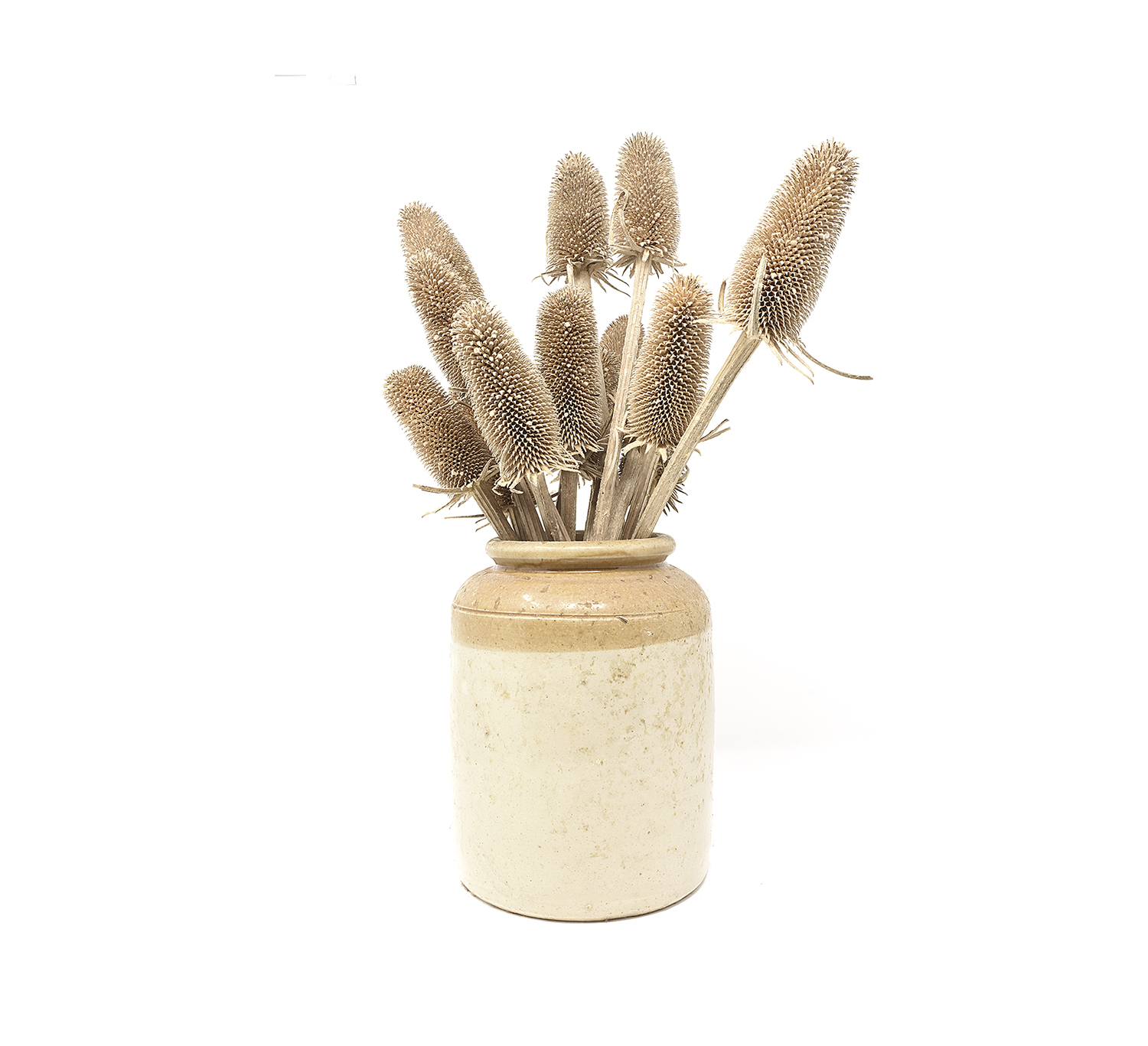
Fuller’s Teasels
Grown for many years in the fields around Coggeshall, Fullers Teasels were used in the cloth trade to raise the nap on cloth. The teasel heads once dried were fitted into special rollers and the cloth fed through to give a soft surface. These teasels are different from those of the native wild teasel – they are much larger, less rounded and importantly the ‘spikes’ are recurved and form hooks and it is these which grasp and lift the surface of the cloth. Fullers teasels can still be found growing here and there on field edges around Coggeshall. They were a hard crop to work and were dried in sheds and stored in Teasel lofts of which a few survive in the town. Nowadays a metal card is used which is more hardwearing but many claim gives an inferior result.
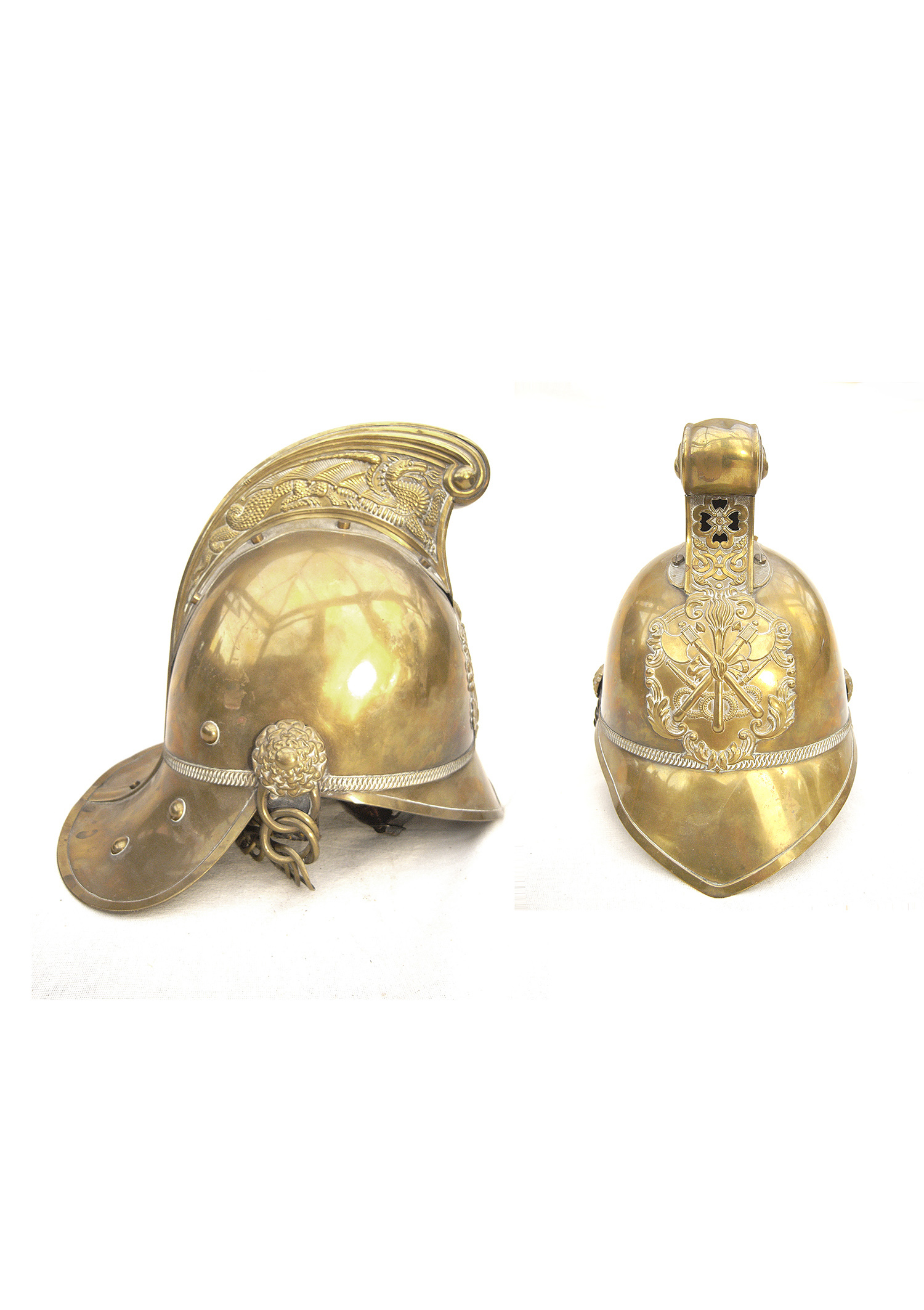
Coggeshall Fire Brigade Brass Helmet
In 1939 with war looming, Braintree Rural District Council appointed a new Chief Fire Officer Lewis White. The local fire engine at the time was based in Kelvedon but when the crew met Mr White they found him deeply objectionable and resigned en masse. A new crew was recruited in Coggeshall and the Kelvedon fire engine found a home in a brand new fire station on Market Hill. After witnessing a call-out, Denis Wood recalled, ‘You saw those men with their brass hats sitting each side of the engine and the bell ringing, it just looked a picture and really impressed me as a young man’.
This helmet belonged to one of that crew, Stan Saunders, and was donated to the museum by his son Tony. Stan was wearing it when the Coggeshall brigade were called in to help fight the huge dockland fires at Purfleet on Thameside in September 1940. Their actions during that time were commended by the officer in charge in a letter to Lewis White. When the fire service was nationalised in 1941 the old Victorian helmets were replaced with standard Brodie ‘tin hats’ and Coggeshall’s lovely, gleaming fire engine in its glorious vermillion and highly polished brass was painted over in drab wartime grey.
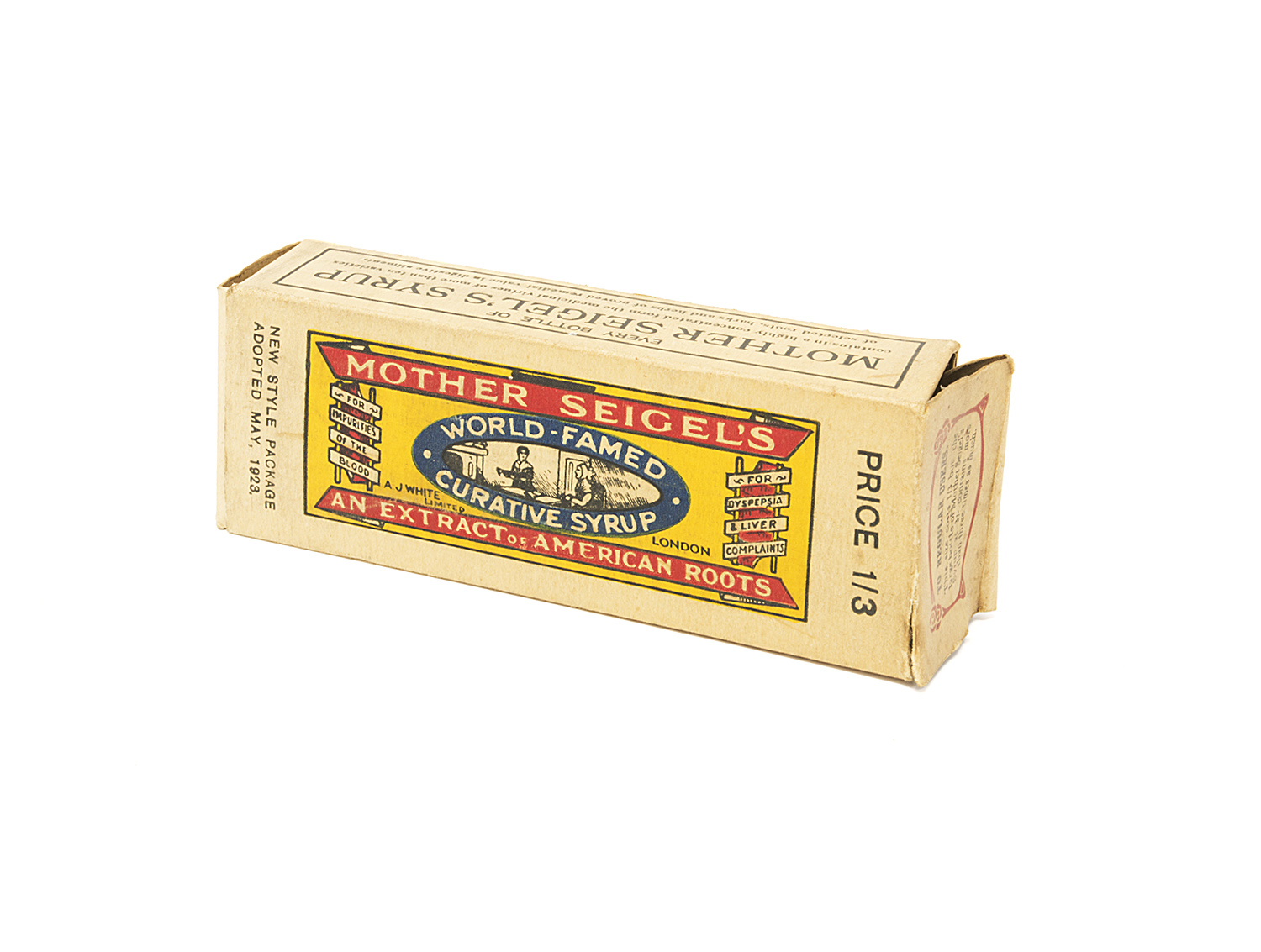
Mother Siegel’s Syrup
The World Famed curative Syrup from American Roots
For headaches, constipation, back aches, nervousness, biliousness and despondency. Acts directly on the stomach, liver and bowels and quickly restores them to healthy action!
For regular users this size costs 1/3d but the large size of Mother Siegel’s Syrup at 3/- contains more than three times as much.
This product dated 1923 was originally of American Shaker origin and from about 1885 was made in England by A J White Ltd of Farringdon Road, London.
The box is about 12.5 x 5 cms

World War 1 – The Coggeshall Evacuation Plan
This interesting document dates from the summer of 1914, soon after Britain declared war against Germany.
In the event of a German invasion Coggeshall residents were to be evacuated to Oxfordshire. The routes to be taken out of Coggeshall were specified, a journey of up to 12 hours by horse and wagon was to be expected. Much livestock would have been destroyed, as would any remaining supplies of fuel.
In fact, the threat of a German invasion was extremely remote. The Royal Navy controlled both the English Channel and North Sea, and aircraft were still in their infancy. Nonetheless, fears had been fuelled by popular fiction prior to the war by a series of alarmist novels, most notably ‘The Riddle of the Sands’ (1903) by Erskine Childers, widely celebrated as a groundbreaking work of espionage fiction and ‘The Invasion of 1910’ by William Le Queux which envisaged a successful invasion of Britain by a German army of 250,000 troops and sold over a million copies.
Therefore to many contemporaries the threat of an imminent German attack was very real.
From the archive of Coggeshall Museum
Html White background ignore this text it is just to increase the picture size

Design for the Painted and Stencilled East End of the Church
Restoration of the parish church which started in 1850 eventually coincided with the High Victorian vogue for painted and stenciled decorative schemes. A scheme was commissioned for the chancel of the church probably in 1881, from Messrs Clayton & Bell. They were preeminent at the time for their stained glass but also much involved in decorative schemes for all sorts of buildings.
The illustration is their projected design for the east end of the church. The first part of the polychromatic decoration was begun in 1882 and the whole scheme completed in early 1889. Black and white photos show that the scheme was executed exactly as planned – and we are fortunate that this painting has survived to show the colours.
The scheme had a short life – damaged by cracking, falling plaster and weathering following the bombing of the church in 1940, it was decided that the paintings were impossible to restore – and by the 1950s anything Victorian was anyway held in very low regard. So the walls were whitewashed.
From the archive of Coggeshall Museum